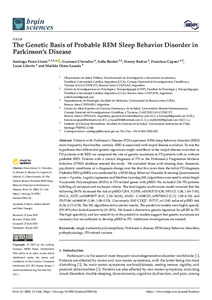Por favor, use este identificador para citar o enlazar este ítem:
https://repositorio.uca.edu.ar/handle/123456789/17344| Título: | The genetic basis of probable rem sleep behavior disorder in Parkinson’s disease | Autor: | Pérez Lloret, Santiago Chevalier, Guenson Bordet, Sofía Barbar, Hanny Capani, Francisco Udovin, Lucas D. Otero Losada, Matilde |
Palabras clave: | ENFERMEDAD DE PARKINSON; ENFERMEDADES NEURODEGENERATIVAS; POLIMORFISMO DE NUCLEÓTIDO SIMPLE; TRASTORNOS DE LA CONDUCTA; SUEÑO REM; FISIOPATOLOGÍA | Fecha de publicación: | 2023 | Editorial: | MDPI | Cita: | Perez Lloret, S., Chevalier, G., Bordet, S. et al. The genetic basis of probable rem sleep behavior disorder in Parkinson’s disease [en línea]. Brain Sciences. 2023, 13, 1146. doi: 10.3390/brainsci13081146. Disponible en: https://repositorio.uca.edu.ar/handle/123456789/17344 | Resumen: | Abstract: Patients with Parkinson’s Disease (PD) experience REM sleep behavior disorder (RBD) more frequently than healthy controls. RBD is associated with torpid disease evolution. To test the hypothesis that differential genetic signatures might contribute to the torpid disease evolution in PD patients with RBD we compared the rate of genetic mutations in PD patients with or without probable RBD. Patients with a clinical diagnosis of PD in the Parkinson’s Progression Markers Initiative (PPMI) database entered the study. We excluded those with missing data, dementia, psychiatric conditions, or a diagnosis change over the first five years from the initial PD diagnosis. Probable RBD (pRBD) was confirmed by a REM Sleep Behavior Disorder Screening Questionnaire score > 5 points. Logistic regression and Machine Learning (ML) algorithms were used to relate Single Nucleotide Polymorphism (SNPs) in PD-related genes with pRBD. We included 330 PD patients fulfilling all inclusion and exclusion criteria. The final logistic multivariate model revealed that the following SNPs increased the risk of pRBD: GBA_N370S_rs76763715 (OR, 95% CI: 3.38, 1.45–7.93), SNCA_A53T_rs104893877 (8.21, 2.26–36.34), ANK2. CAMK2D_rs78738012 (2.12, 1.08–4.10), and ZNF184_rs9468199 (1.89, 1.08–3.33). Conversely, SNP COQ7. SYT17_rs11343 reduced pRBD risk (0.36, 0.15–0.78). The ML algorithms led to similar results. The predictive models were highly specific (95–99%) but lacked sensitivity (9–39%). We found a distinctive genetic signature for pRBD in PD. The high specificity and low sensitivity of the predictive models suggest that genetic mutations are necessary but not sufficient to develop pRBD in PD. Additional investigations are needed. | URI: | https://repositorio.uca.edu.ar/handle/123456789/17344 | ISSN: | 2076-3425 | Disciplina: | MEDICINA | DOI: | 10.3390/brainsci13081146 | Derechos: | Acceso abierto | Fuente: | Brain Sciences. 2023, 13, 1146 |
| Aparece en las colecciones: | Artículos |
Ficheros en este ítem:
| Fichero | Descripción | Tamaño | Formato | |
|---|---|---|---|---|
| genetics-basis-probable.pdf | 261,79 kB | Adobe PDF |  Visualizar/Abrir |
Visualizaciones de página(s)
30
comprobado en 27-abr-2024
Descarga(s)
20
comprobado en 27-abr-2024
Google ScholarTM
Ver en Google Scholar
Altmetric
Altmetric
Este ítem está sujeto a una Licencia Creative Commons

